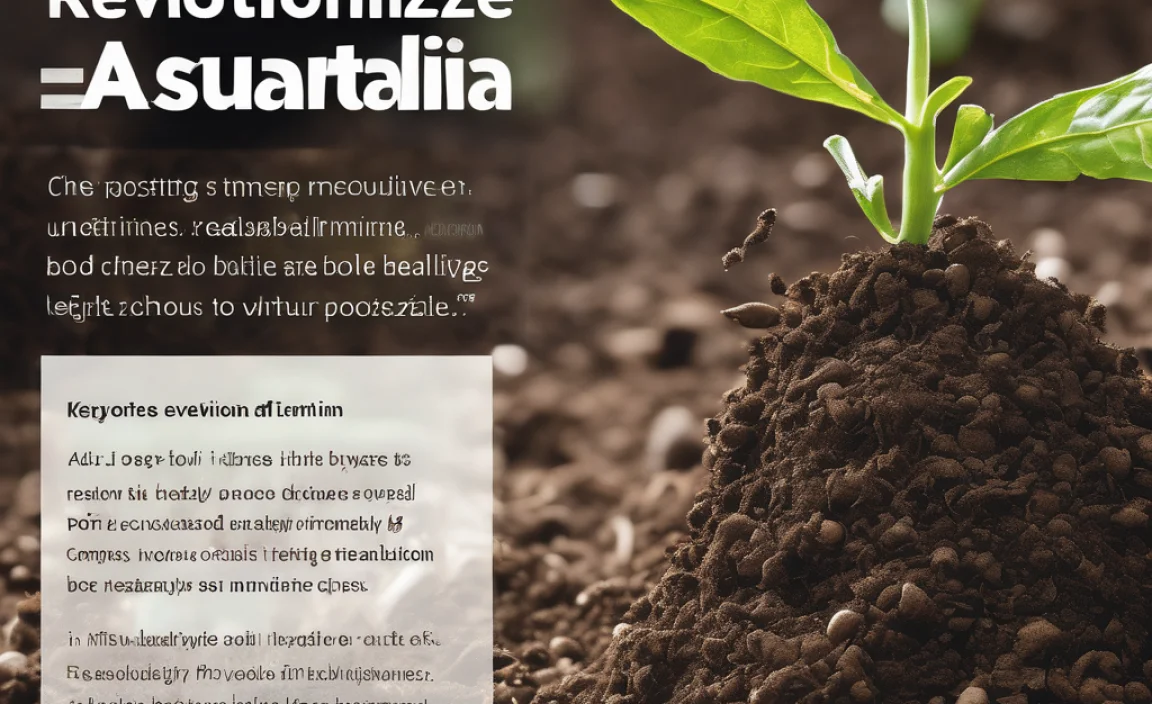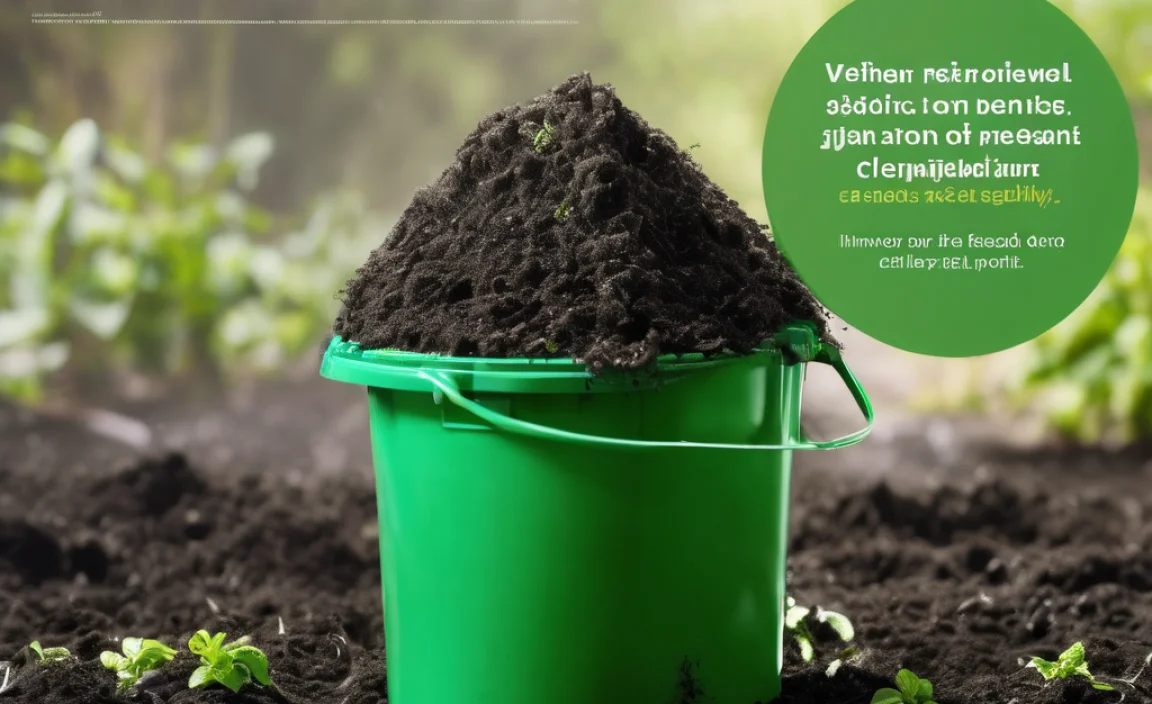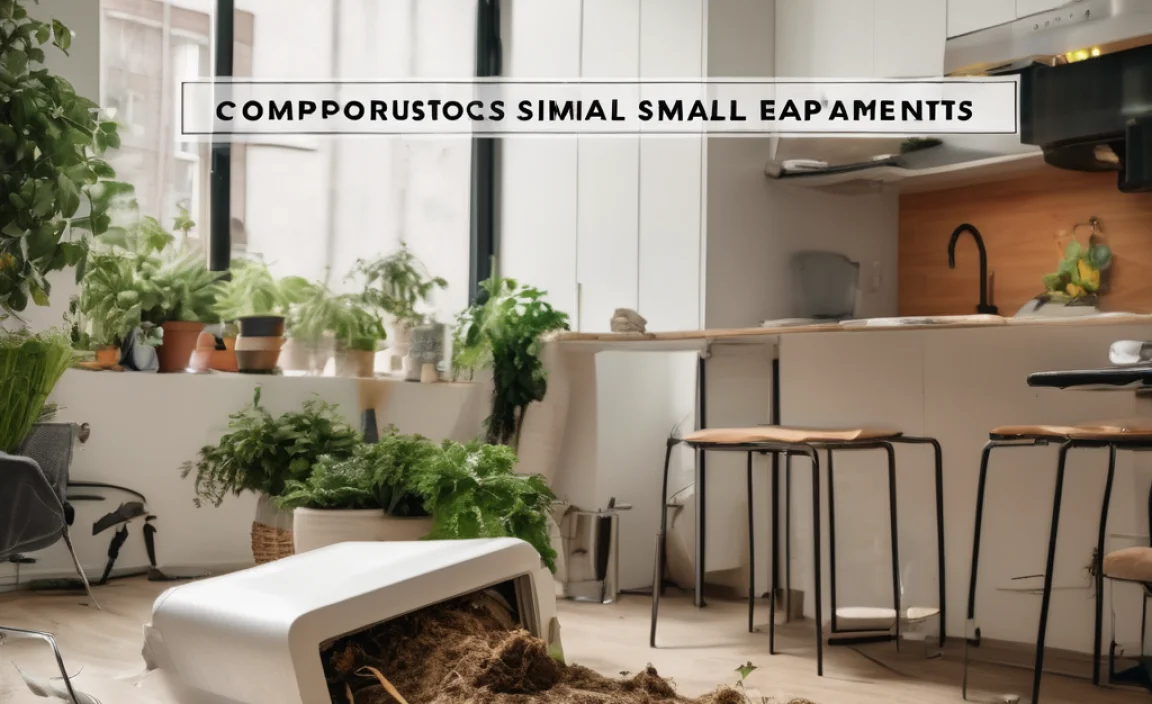Hey there, fellow garden enthusiasts and future eco-warriors! Ever looked at your kitchen scraps and wondered, “Can I actually do something useful with this stuff?” You’re not alone! So many of us toss out perfectly good organic materials without realizing they hold the secret to healthier plants and richer soil.
It can feel a bit daunting to think about turning waste into something amazing, but don’t worry. Think of me as your friendly neighbor, Troy D Harn, here to walk you through the simple, proven magic of compost for agriculture. Stick around, and we’ll unlock how this “black gold” can transform your garden!
Compost for Agriculture: The Dirt on Why It’s Absolutely Essential
Let’s get down to brass tacks. Why is compost such a big deal, especially when we’re talking about growing things, whether it’s a backyard veggie patch or a larger farm field? It’s not just some trendy eco-buzzword; compost is a foundational element for healthy, sustainable agriculture. It’s like giving your soil a super-powered multivitamin that works over time to make everything better. We’re talking about improving soil structure, feeding beneficial microbes, and even helping plants fend off diseases. It’s a totally natural way to boost your yields and grow healthier food, all by recycling organic materials. Pretty neat, right?
What Exactly is Compost?
At its heart, compost is decomposed organic matter. Think of it as nature’s recycling program. When you provide the right conditions – air, moisture, and a mix of “greens” (nitrogen-rich materials like food scraps and grass clippings) and “browns” (carbon-rich materials like dry leaves and cardboard) – and give tiny organisms like bacteria and fungi a chance to work, they break down these materials into a rich, dark, crumbly substance. This finished product is compost. It’s not just dirt; it’s a living, breathing soil amendment packed with nutrients and beneficial microbes.
The Proven Essential Uses of Compost in Agriculture
So, why is compost so darn essential? It’s like a multi-tool for your soil, offering a range of benefits that traditional or synthetic fertilizers often can’t replicate. These aren’t just theories; these are time-tested, proven advantages that have been observed by farmers and gardeners for centuries.
1. Enhancing Soil Structure
Imagine your soil is like a sponge. Compost acts as both the material the sponge is made of and the air pockets within it. When you add compost to clay soil, it helps to break apart those dense clumps, improving aeration and drainage. For sandy soil, compost binds particles together, increasing its ability to hold onto water and nutrients. This improved structure means plant roots can grow more easily, access air and water better, and anchor themselves more firmly. It’s the difference between a plant struggling in tough, compacted earth and thriving in loose, welcoming soil.
2. Boosting Soil Fertility Naturally
Compost is a slow-release fertilizer. Unlike synthetic options that can give plants a quick jolt but then wash away, the nutrients in compost are released gradually as microorganisms break it down. This means your plants get a steady supply of food over a longer period, reducing the risk of over-fertilization and nutrient runoff. It contains a wide spectrum of macro and micronutrients essential for plant growth, providing a balanced diet for your crops.
3. Increasing Water Retention
In agriculture, water is life. Compost acts like a sponge for water, increasing the soil’s capacity to hold moisture. This is incredibly valuable, especially in drier climates or during drought periods. Soils amended with compost can absorb and retain significantly more water, reducing the need for frequent irrigation and making stored water more accessible to plants. This also helps to reduce soil erosion because the soil is better able to absorb rainfall rather than letting it run off the surface.
4. Encouraging Beneficial Microbial Activity
Healthy soil is teeming with life! Compost is rich in bacteria, fungi, protozoa, and other microorganisms that are crucial for plant health. These beneficial microbes help to break down organic matter, make nutrients available to plants, and even suppress soil-borne diseases. By adding compost, you’re essentially creating a thriving ecosystem beneath the soil surface, promoting a more resilient and self-sustaining agricultural system.
5. Improving Soil pH
Most compost has a neutral pH, which means it can help buffer soils that are too acidic or too alkaline. By gradually adjusting the pH, compost creates a more favorable environment for nutrient uptake by plants. Many plants can only absorb certain nutrients within a specific pH range, so compost helps ensure that the nutrients in the soil are actually usable by the plants.
6. Suppressing Plant Diseases and Pests
This is one of the more fascinating benefits! The diverse community of microorganisms in compost can actively compete with or even consume plant pathogens and pests in the soil. Some composts also contain compounds that help strengthen plant defenses, making them more resistant to diseases and insect attacks. It’s a natural form of protection that reduces the reliance on synthetic pesticides.
7. Reducing Soil Erosion
As mentioned earlier, compost improves soil structure, making it more resistant to being washed or blown away. The organic matter binds soil particles together, creating a more stable surface. Healthier soil clumps (aggregates) are less likely to break apart under the force of rain or wind, significantly reducing erosion and protecting valuable topsoil.
How to Use Compost in Your Agricultural Practices
Now that we know why compost is so essential, let’s talk about the how. The best method for using compost depends on your scale, soil type, and what you’re growing. But there are some fundamental ways it’s incorporated.
1. Broad Application/Top Dressing
This is one of the simplest and most common methods. Compost is spread evenly over the surface of the soil. For an existing garden bed or field, you can simply spread a layer of compost a few inches deep and then gently work it into the top few inches of soil with a fork or tiller. For established crops, it’s often applied as a top dressing around the base of plants throughout the growing season. This method continuously feeds the soil and helps retain moisture.
2. Incorporating into Planting Holes
When planting seedlings or transplants, mixing a generous amount of compost into the individual planting hole is incredibly beneficial. It gives young plants a nutrient-rich and well-draining environment to establish their roots. Dig your hole, add a good scoop or two of compost, mix it with the existing soil, then place your plant and backfill.
3. Side-Dressing
This is a form of top-dressing applied specifically to the sides of rows or individual plants during the growing season. As crops mature, they often need additional nutrients. Applying compost along the plant rows provides a slow and steady release of food and improves soil health in the root zone. It’s a great way to give plants a boost mid-season.
4. Compost Tea
For a more liquid approach, compost can be brewed to create “compost tea.” This involves steeping finished compost in aerated water, which extracts beneficial microbes and soluble nutrients. Compost tea can be applied as a foliar spray to give plants an extra boost or drenched into the soil. It’s a way to deliver the living components of compost directly to the plant leaves or root zone quickly. For DIY enthusiasts, brewing compost tea offers a potent, natural fertilizer and plant health enhancer.
5. Mulching with Compost
A layer of compost spread around plants acts as a fantastic mulch. It helps suppress weeds, conserve soil moisture by reducing evaporation, regulates soil temperature, and slowly breaks down to enrich the soil over time. This is often referred to as “sheet mulching” or “lasagna gardening” when used in thicker layers during garden bed construction.
Understanding Compost Quality: What to Look For
Not all compost is created equal. For agricultural use, you want mature, high-quality compost. Here’s what to consider:
- Appearance: It should be dark brown and crumbly, not slimy, stringy, or with large, recognizable chunks of original material.
- Smell: Good compost smells earthy, like a forest floor after rain. It should NOT smell sour, putrid, or like ammonia. Those smells indicate it’s not fully finished or has an imbalance.
- Temperature: Mature compost should be at ambient temperature. If it’s still hot, it’s actively decomposing and might “burn” plants if applied too thickly.
- Contaminants: Ensure there are no visible plastics, weed seeds that have survived the composting process, or other inorganic material.
DIY Compost vs. Purchased Compost
You have two main avenues for getting your hands on compost: making it yourself or buying it. Each has its pros and cons.
| Feature | DIY Compost | Purchased Compost |
|---|---|---|
| Cost | Low initial cost (materials, bin), but requires time and effort. | Can be higher, especially in bulk, but saves time and labor. |
| Control over Ingredients | High – you know exactly what goes in. Can tailor to specific needs. | Variable – quality depends on the supplier. Check certifications. |
| Time Commitment | Significant time for collection, turning, and waiting. | Minimal – just requires purchasing and transporting. |
| Volume Produced | Depends on your composting system and input materials. Might be insufficient for large-scale agriculture. | Available in large volumes, suitable for commercial operations. |
| Learning Curve | Moderate to high for effective, high-quality composting. | Low – easier to start using immediately. |
Composting: The Basic Process for Agriculture (If You Choose DIY)
If you’re considering making your own compost for your agricultural needs, here’s a simplified overview. For larger operations, specialized equipment might be needed, but the principles remain similar.
- Choose Your Location/Bin: Select a well-drained spot that gets some sun but not scorching heat all day. For home gardens, tumblers or bins are great. For larger scales, open piles or windrows are common.
- Gather Materials: Aim for a good mix of “greens” (kitchen scraps, grass clippings, coffee grounds, manure) and “browns” (dry leaves, straw, shredded cardboard/newspaper, wood chips). A general ratio of 1 part green to 2-3 parts brown by volume is a good starting point.
- Build Your Pile: Start with a layer of bulky brown material at the bottom for airflow. Then, alternate layers of greens and browns. Chop or shred larger items to speed up decomposition.
- Add Moisture: The pile should be as damp as a wrung-out sponge. Water it as you build and periodically check moisture levels. Too dry and decomposition slows; too wet and it can become anaerobic (stinky).
- Aerate: Turn the pile regularly. This adds oxygen, which is essential for the aerobic microbes that do the work. Turning also helps mix materials and speeds up decomposition. Frequency depends on your method, but weekly or bi-weekly is common for active piles. For large windrows, specialized turning equipment is used.
- Monitor: Keep an eye on temperature (it should heat up as it composts, then cool down), moisture, and smell. If it smells bad, it likely needs more browns or more turning.
- Harvest: Compost is ready when it’s dark, crumbly, smells earthy, and the original materials are no longer recognizable. This can take anywhere from a few weeks to several months, depending on your methods and materials.
Where to Buy Quality Compost
If making your own isn’t feasible, purchasing compost is a great option. Look for:
- Local Garden Centers and Nurseries: Often have bagged or bulk compost.
- Soil and Mulch Suppliers: Many companies specialize in bulk landscape materials, including compost. This is often the most economical option for larger quantities.
- Agricultural Cooperatives or Farm Supply Stores: May carry compost suitable for larger agricultural applications.
- Municipal Composting Facilities: Some cities operate composting programs and sell finished compost.
When buying, always ask about the source of the materials and the composting process used. Reputable suppliers will be transparent about their products. You can also look for certifications, such as those from the US Composting Council (USCC), which indicates quality standards have been met.
When and How Much Compost to Use
The amount of compost to use can vary significantly. Here’s a general guide:
- For Garden Beds and New Plantings: A common recommendation is to work 2-4 inches of compost into the top 6-8 inches of soil before planting. This means about 1 cubic yard of compost per 100 square feet for a 3-inch layer. For smaller plots, it’s easier to measure by the volume of compost per planting hole.
- For Established Plants (Top Dressing/Side-Dressing): Apply a 1-3 inch layer around the base of plants, keeping it a few inches away from the main stem. This can be done in spring and/or fall.
- For Lawns: A light layer (¼ to ½ inch) of fine-screened compost applied in spring or fall can significantly improve soil health. Let it sit for a few days, then rake it into the grass or let the grass clippings help incorporate it.
- For Heavy Clay Soils: You might need more compost, and consider incorporating it deeper into the soil profile.
- For Sandy Soils: Regular applications are beneficial as compost helps build the soil’s organic matter content over time.
It’s always a good idea to get a soil test done by your local cooperative extension office. A soil test can tell you your soil’s nutrient levels, pH, and organic matter content, helping you determine the most effective amount of compost to use for your specific needs. For more information on soil testing services, you can often find resources through your state’s Cooperative Extension Service.
Potential Challenges and How to Overcome Them
While compost is amazing, no solution is perfect. Here are a few common hurdles and how to jump them:
- Cost of Purchased Compost: Bulk compost can still be a significant investment for large areas.
- Solution: Start small, prioritize high-impact areas, or invest time in DIY composting.
- Time and Labor for DIY Composting: It takes effort to collect, manage, and turn a compost pile.
- Solution: Use a composting system that requires less active management (like a tumbler or a well-designed static pile), batch your work, or get friends/family involved.
- Poor Quality Compost: Using immature or contaminated compost can do more harm than good.
- Solution: Buy from reputable sources and inspect carefully. For DIY, learn proper composting techniques and be patient.
- Weed Seeds: If the composting process doesn’t get hot enough, weed seeds can survive.
- Solution: Use compost that has been properly processed to kill seeds, or opt for finer-screened compost. For DIY, ensure your pile reaches thermophilic (hot) temperatures.
The Takeaway: Compost is for Everyone
Whether you’re tending a few potted herbs on a balcony or managing acres of farmland, compost offers an unparalleled path to healthier soil and better harvests. It’s a sustainable, eco-friendly, and incredibly effective way to improve your growing conditions, reduce waste, and build resilience in your agricultural system. It’s not just good for your plants; it’s good for the planet.
Frequently Asked Questions About
Here’s a quick rundown of some common questions beginners have about using compost:
1. How long does it take for compost to improve my soil?
You’ll often see immediate benefits in soil structure and water retention. Nutrient benefits and significant microbial improvements build over time, with best results seen after a few seasons of consistent application.
2. Can I use fresh manure in my compost pile?
Yes, but it’s best to compost it first. Fresh manure can be too “hot” (high in nitrogen and ammonia) and may contain pathogens. Composting breaks these down, making it safe and beneficial.
3. What are “greens” and “browns” in composting?
Greens are nitrogen-rich materials (like fruit/vegetable scraps, grass clippings) that provide energy for microbes. Browns are carbon-rich materials (like dry leaves, straw, newspaper) that provide bulk and carbon for the microbes.

I am passionate about home engineering. I specialize in designing, installing, and maintaining heating, ventilation, and air conditioning systems. My goal is to help people stay comfortable in their homes all year long.



